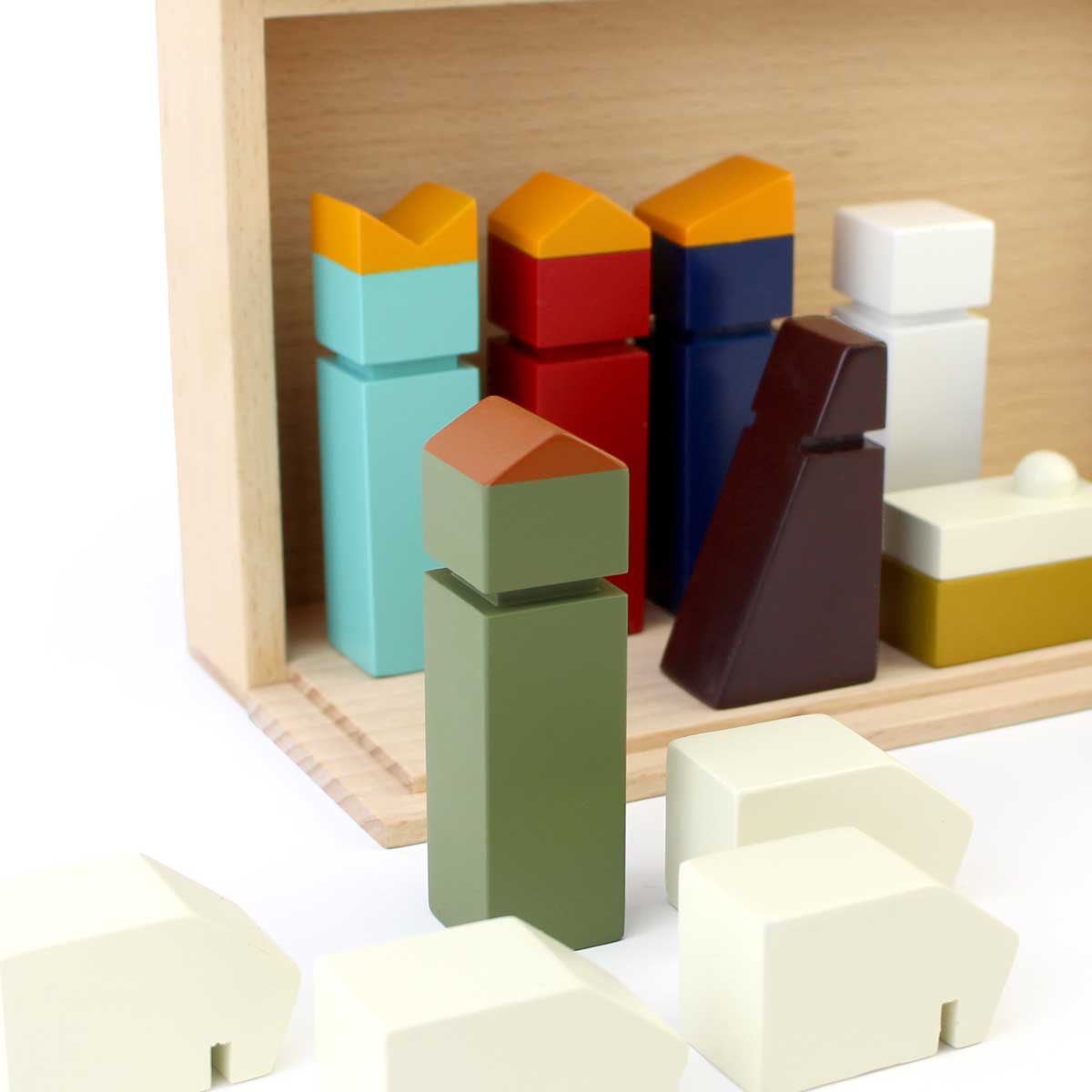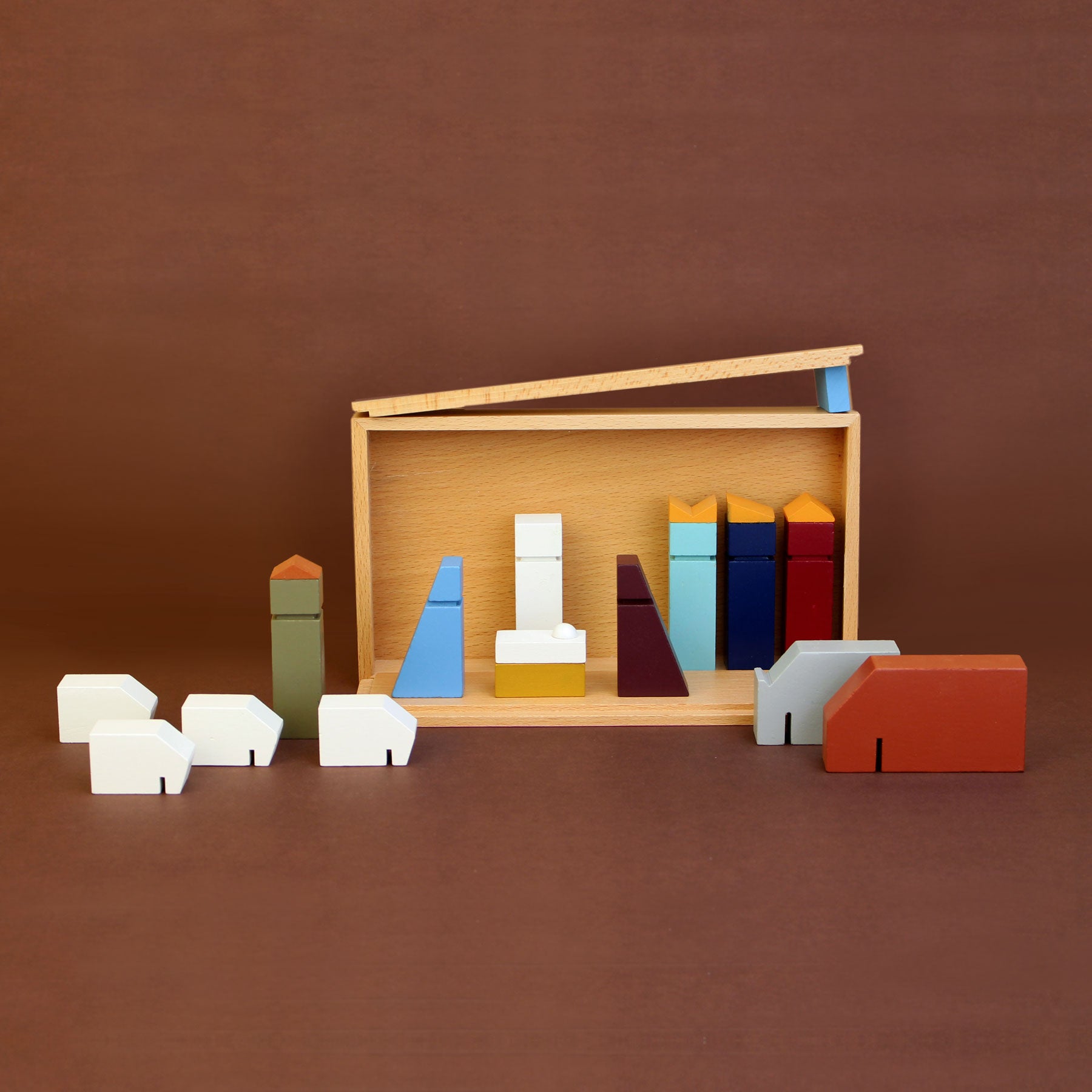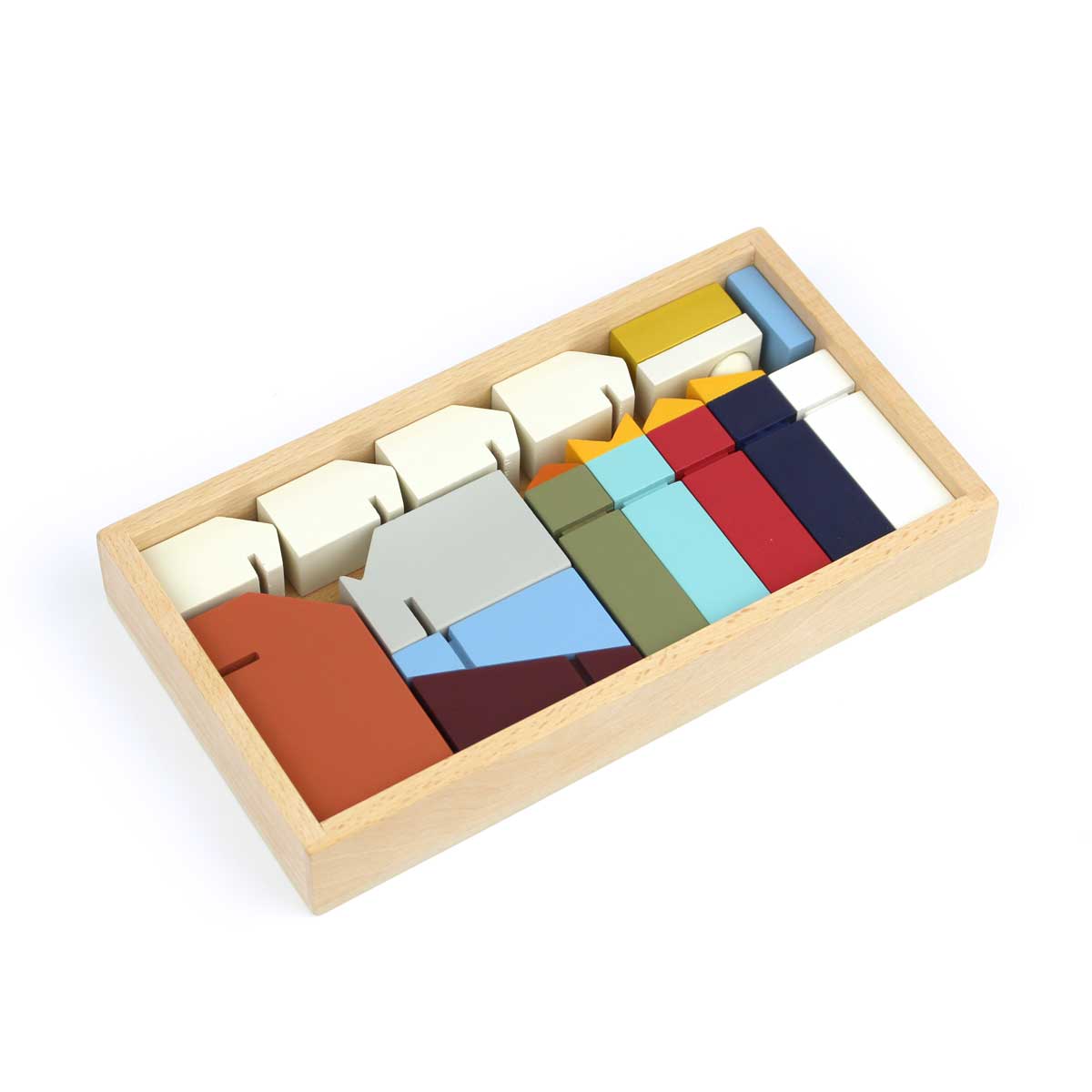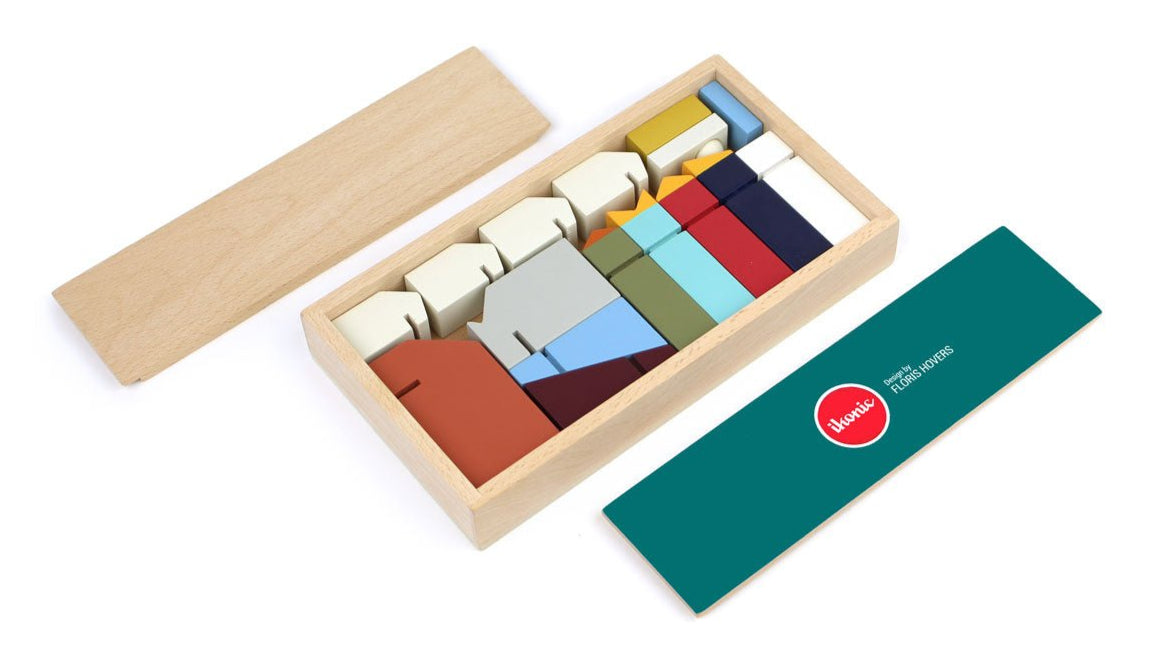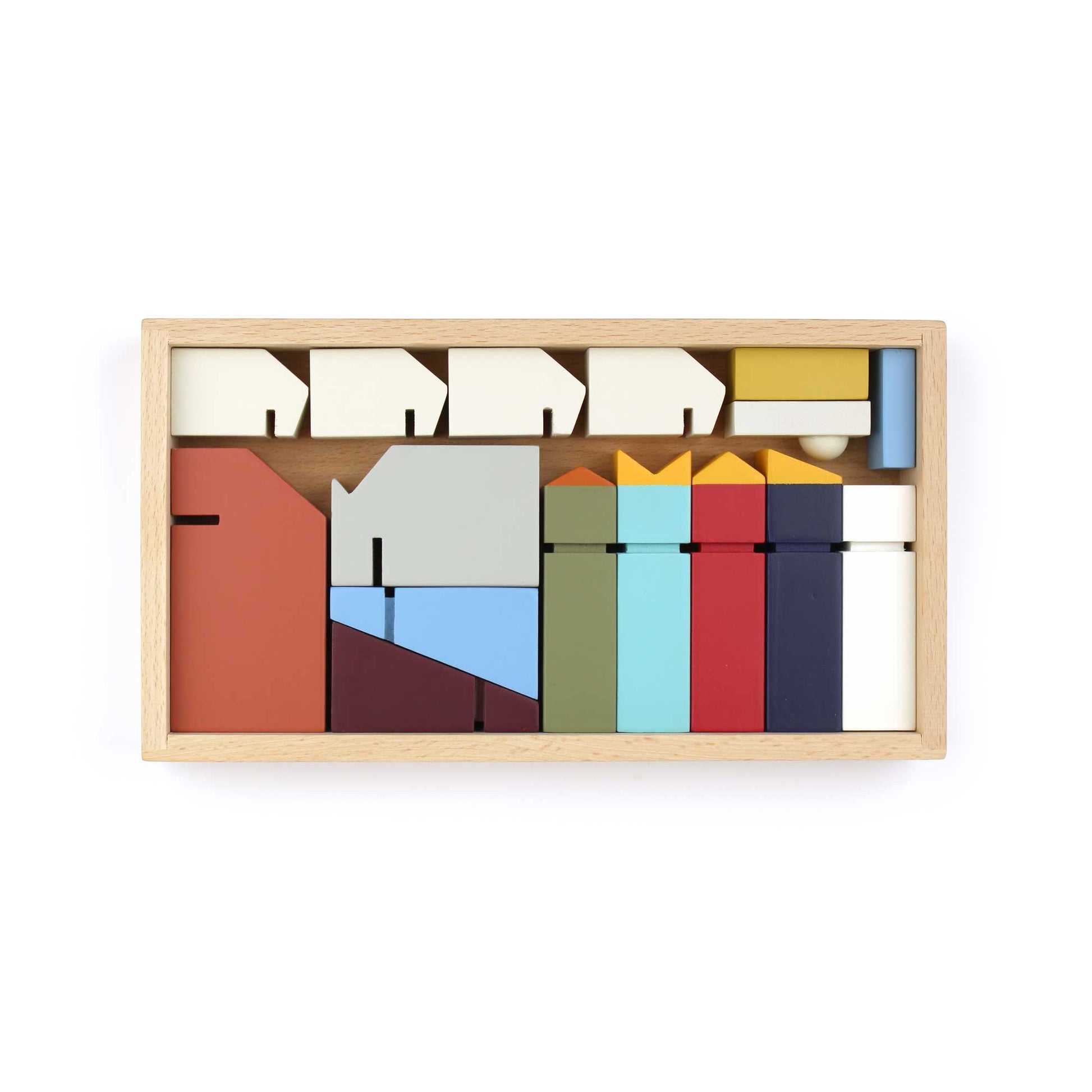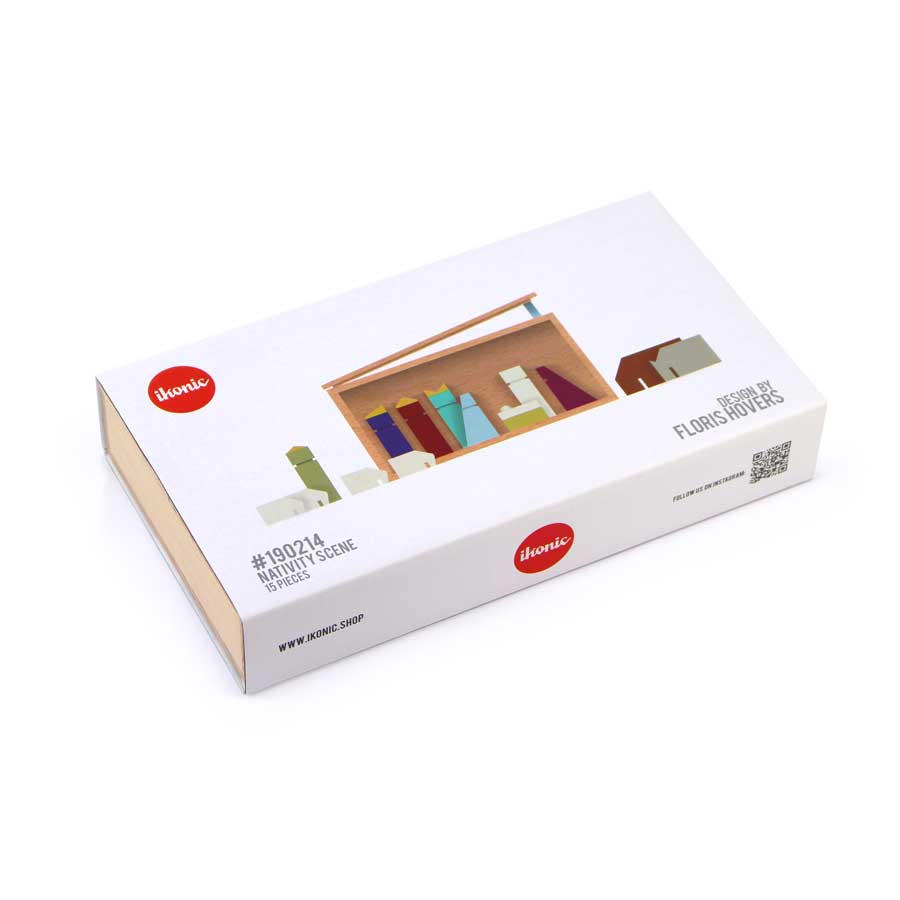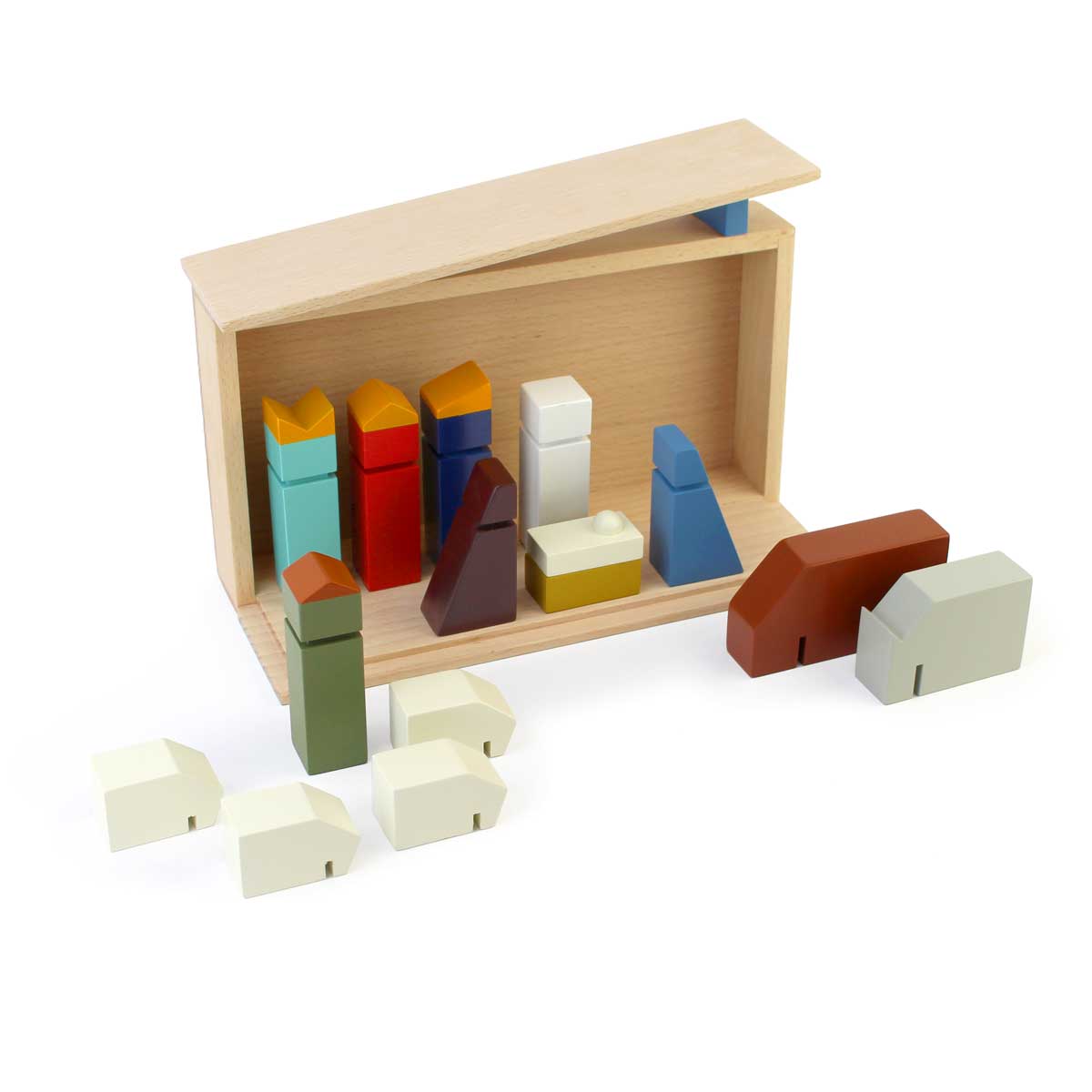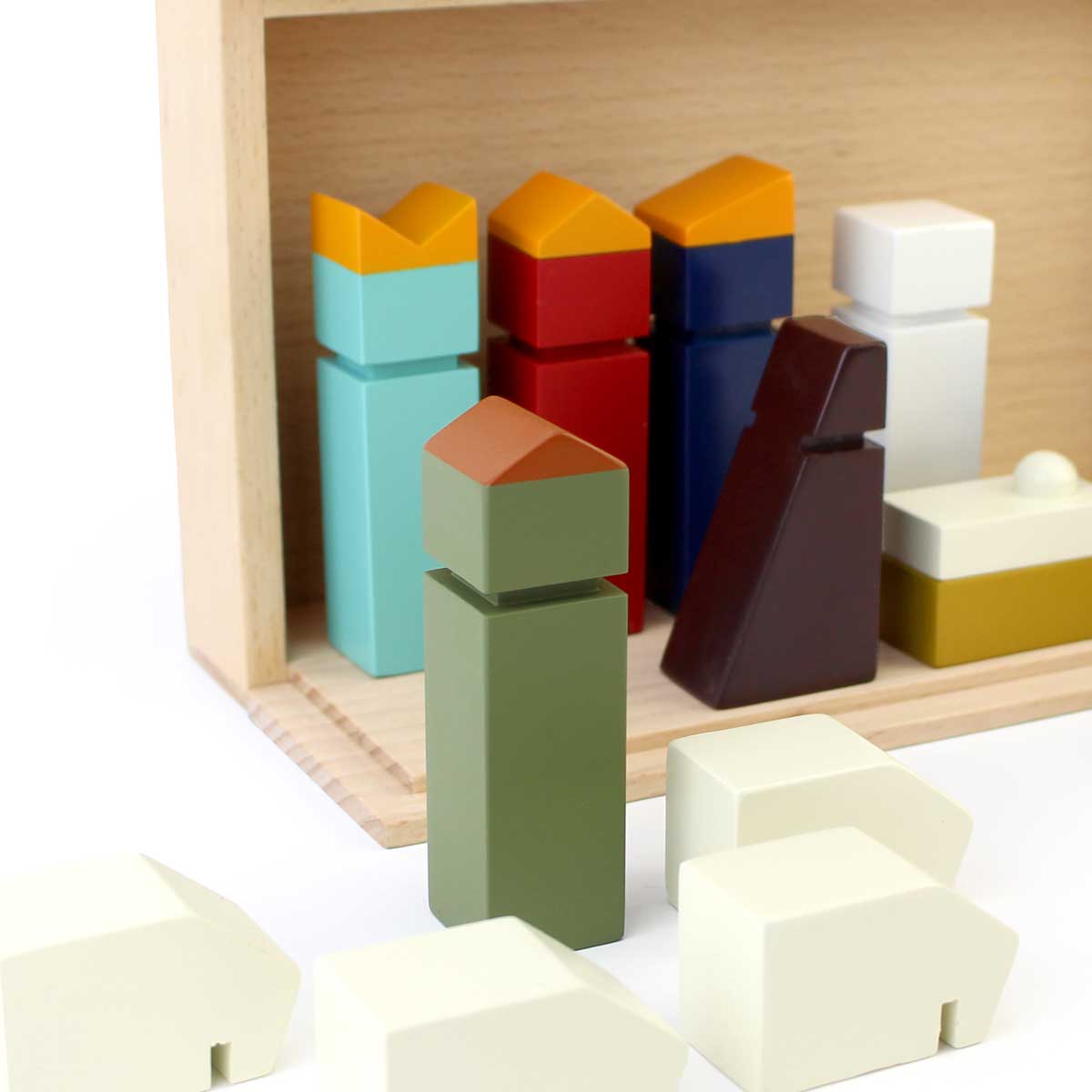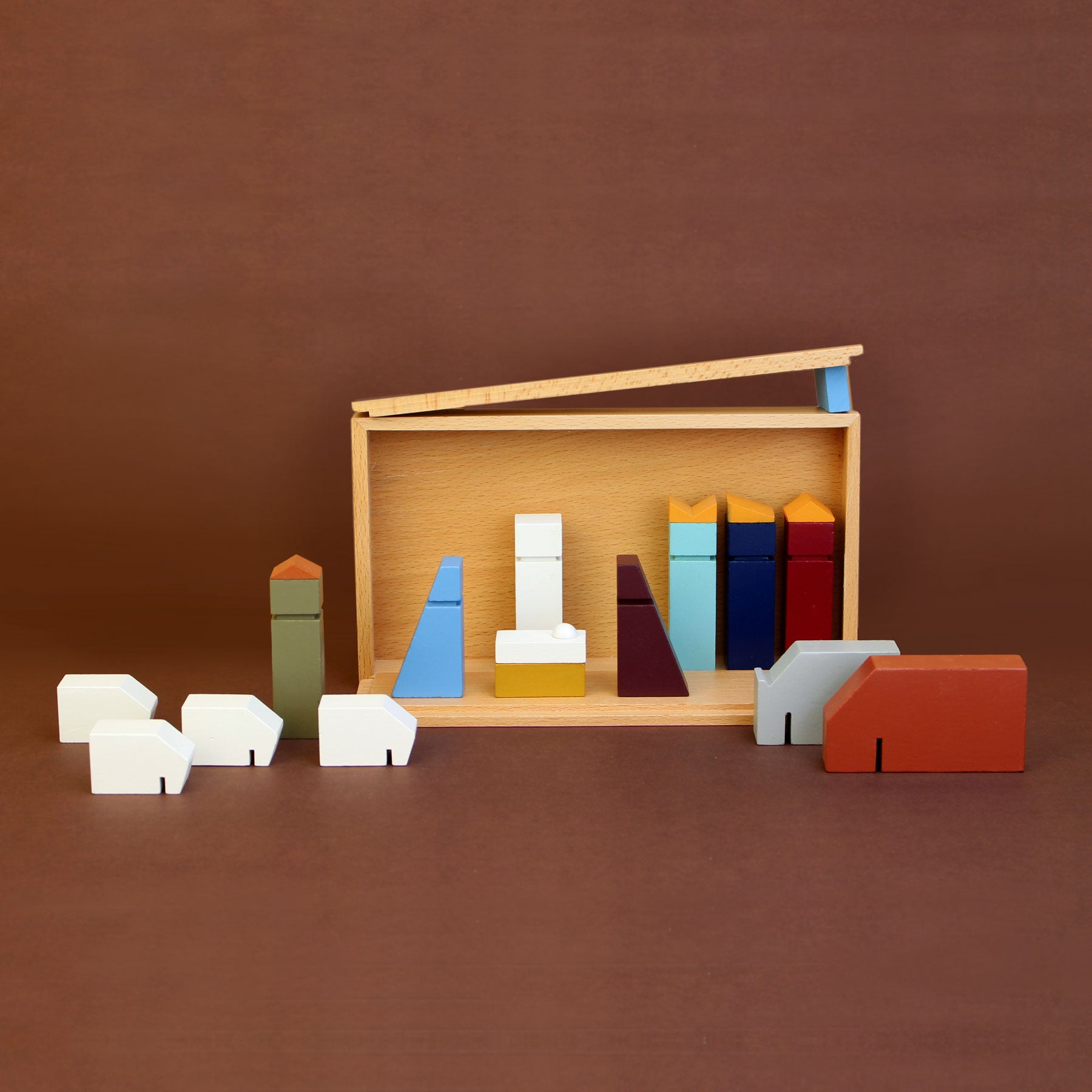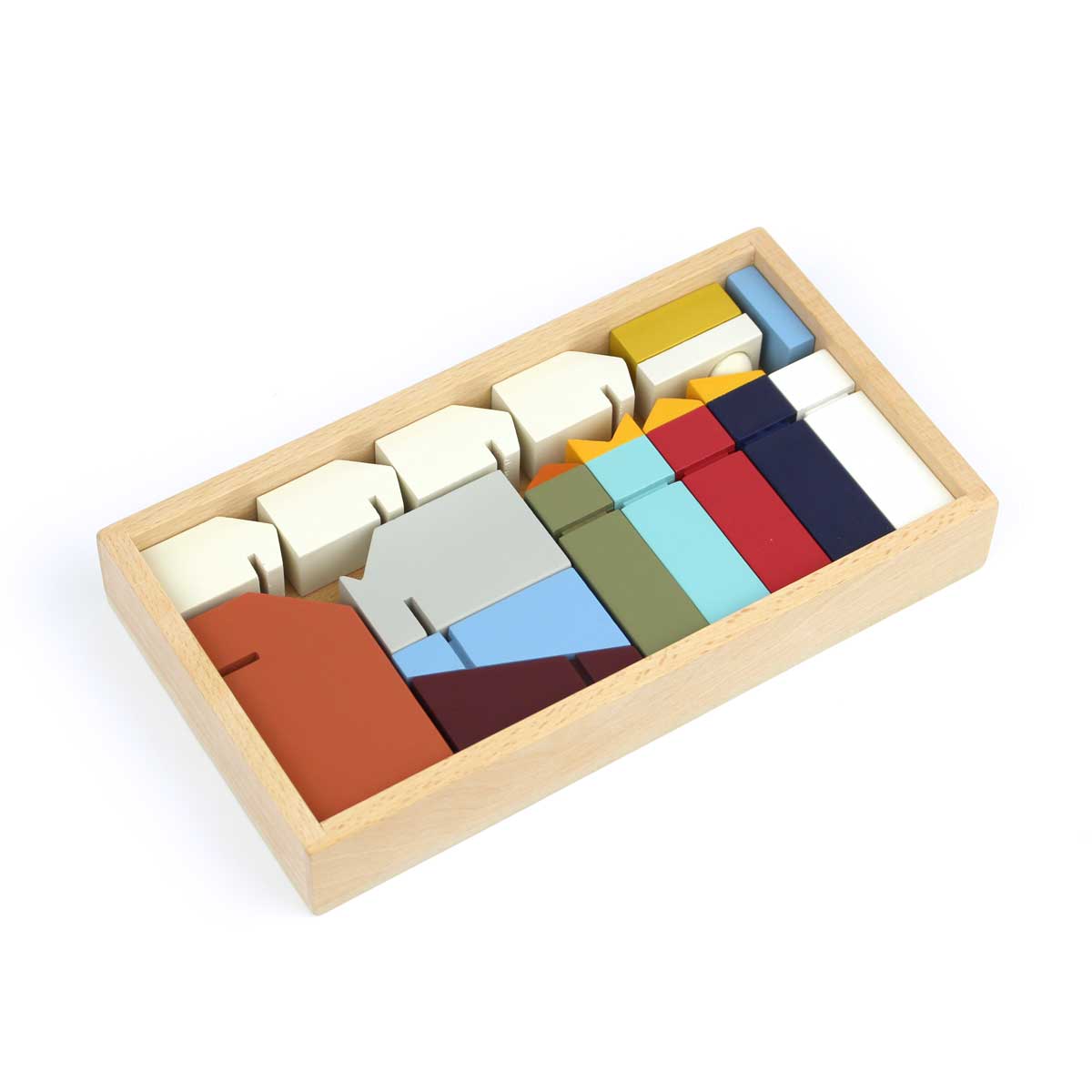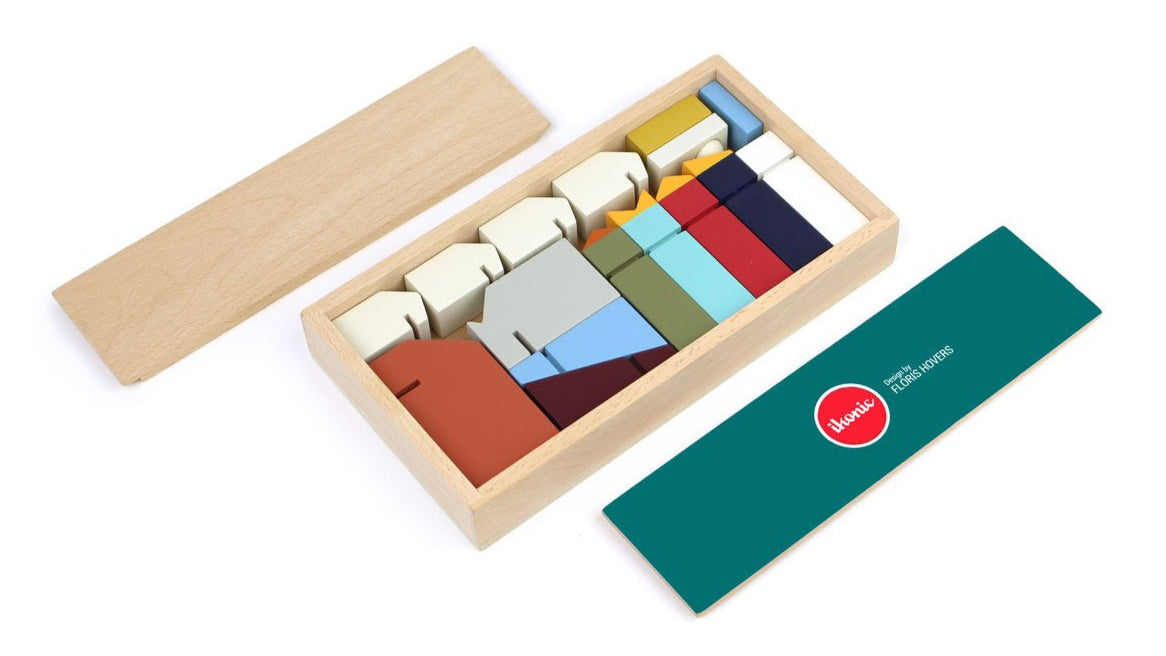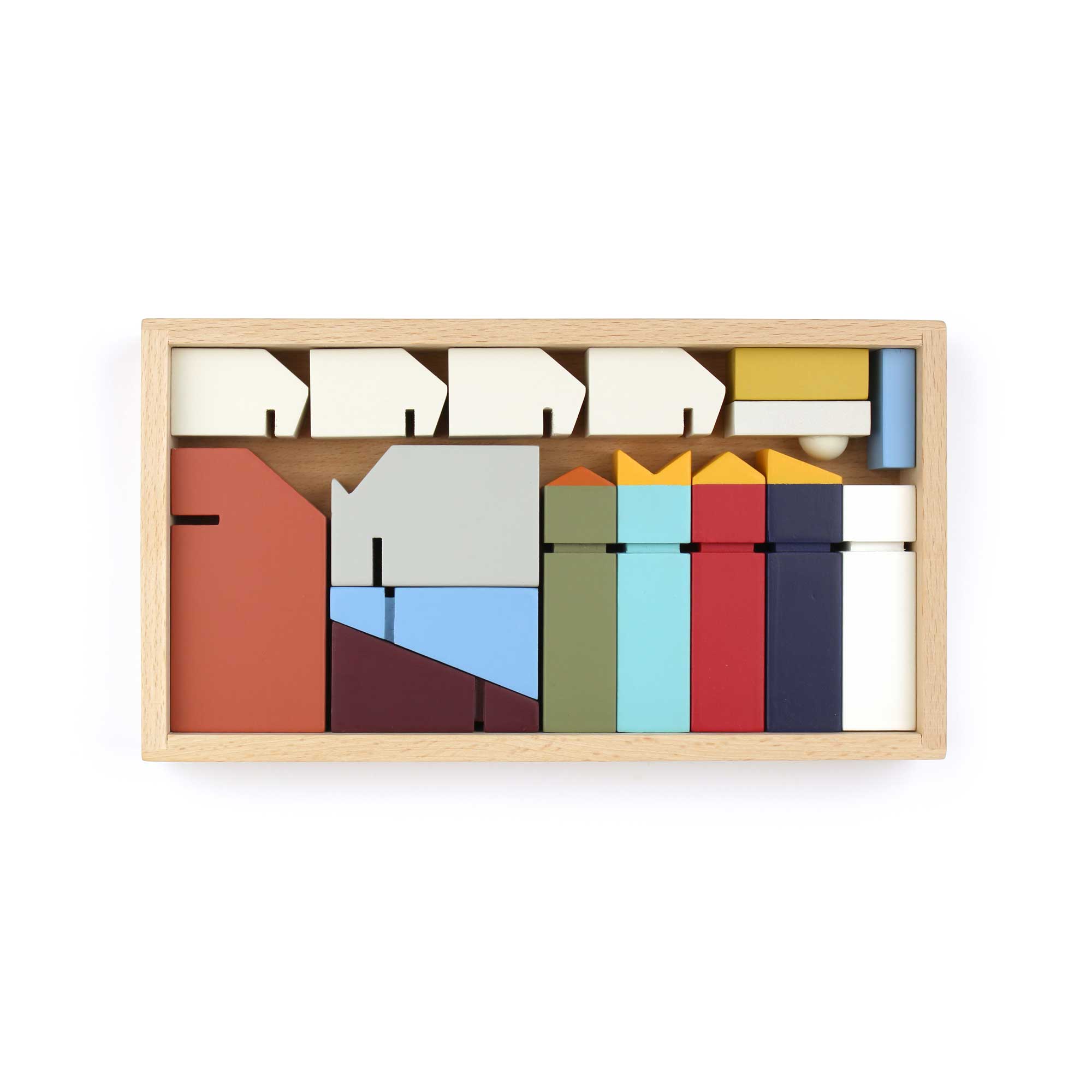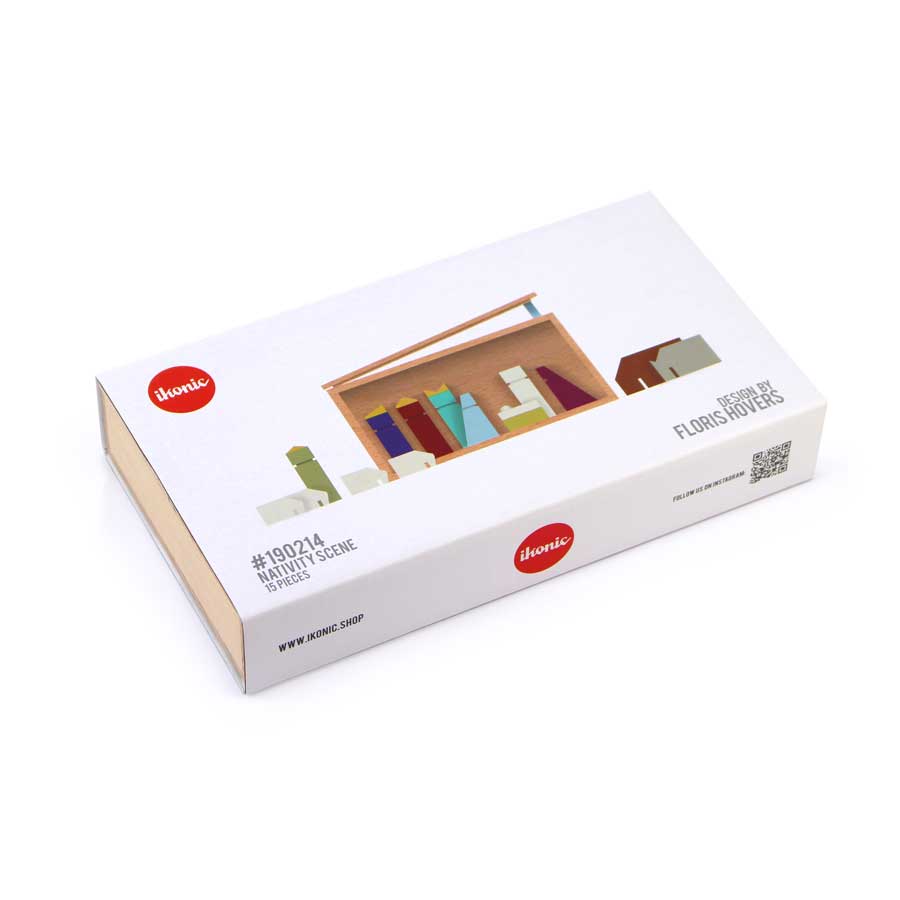
Nativity scene with figurines
Floris Hovers Nativity Scene
Modern Wooden Nativity Scene - design by Floris Hovers
Colorful, minimalist nativity set designed by Floris Hovers. The wooden nativity scene consists of Joseph and Mary, the baby Jesus, the three kings, the angel Gabriel, a shepherd with 4 sheep, an ox and a donkey. The two lids and the wooden storage box together form the stable. The lacquer finish of the figures is of very high quality.
- FSC beech wood
- Dutch Design
- unique design: one of the few modern-abstract nativity scenes
- Easy to store: the wooden stand is also the packaging
- Fits in a modern interior
- Each edition has a different color lid. This edition: turquoise / blue-green
Seasonal product: available while stocks last.
The dimensions of the box are 24 x 13 x 4 cm
A wooden figure (for example a king) is approximately 8 x 2.2 x 2.2 cm
Made in Vietnam
In stock
Share this product

Nativity scenes are one of the most recognizable and beloved traditions during the Christmas season. The nativity scene with figurines tells the story of the birth of Jesus and has been an important element in Christianity during the Christmas season for a long time. But which nativity figurines are essential for an authentic or contemporary stable? What is the difference between traditional and modern nativity figurines? Which nativity figurines are most common in complete sets? And which materials are popular today, such as nativity figurines, wood or ceramics?
In this comprehensive article, you will discover everything about assembling, choosing and buying a nativity scene with figurines. You will find historical backgrounds, current trends, tips for buying nativity figurines, answers to frequently asked questions and inspiring examples for your own complete or modern nativity figurines set. Whether you're dreaming of a classic nativity scene with carved figurines or a minimalist, modern nativity scene, you'll find all the information you need here.

The origin of the nativity scene and figurines
The tradition of the nativity scene with figurines has its roots in the European Middle Ages. The first living nativity scene was organized in 1223 by Francis of Assisi in Greccio, Italy. He wanted to make the Christmas story tangible for ordinary people, who often could not read or write. From then on, the idea quickly spread across Europe, with the depiction of the sacred Christmas story becoming more and more refined and expanded.
Originally, the nativity scene consisted only of the Holy Family: Jesus in the manger, Mary and Joseph. Soon shepherds, angels, wise men and animals such as the ox and donkey were added. In some countries, specific local animals can even be found in nativity scenes, such as llamas in the Andes and water buffaloes in the Philippines. As a result, each nativity scene reflects both the universal message of the Christmas story and local customs and traditions.
Over the centuries, depicting the nativity scene has become a beloved art form. From carved wooden figurines in southern German villages to colourful ceramic statues from Naples, nativity scenes can be found all over the world that depict the story of hope and reconciliation.
Which nativity figurines are the most popular?
Today, the nativity scene with authentic figurines is part of the Christmas decoration in millions of households. But which nativity figurines are the most popular? Sales data from garden centres such as Intratuin and various webshops show that the classic composition, also referred to as the 'basic set', is still a favourite:
- Jesus (in the manger): The centerpiece of the nativity scene.
- Mary and Joseph: Mother and foster father of Jesus.
- The three wise men or kings: Caspar, Melchior and Balthasar bring gifts.
- Shepherd(s): Usually 1, sometimes several, often they have a lamb in their arms at a traditional Christmas group.
- Angel: Messenger; sometimes hanging above the stable.
- Animals: Ox, donkey, and sheep are standard. In larger sets you sometimes see a camel, horse or dromedary.
As extras, a poinsettia, innkeeper, children or other village figurines are regularly added, especially in larger nativity scenes or in themed collections.

The importance of the nativity scene with figurines in your home
For many people, a nativity scene with figurines is not only a decoration, but an important part of the Christmas experience. Building the nativity scene is a meaningful ritual that connects young and old. In some families, there is even the tradition of placing the baby Jesus in the manger on Christmas Eve, so that the Christmas story 'comes to life'.
Also in schools, churches and squares, complete nativity scenes with figurines can be admired every year. For example, large nativity figurines in wood are still popular in parishes and town halls, while smaller sets in living rooms and families with young children are a favorite because of their scale and sometimes playful design.
Within the Catholic tradition, more and more regional variants appear, such as Provençal santons in the south of France or the beautifully decorated Polish 'szopki' in Krakow.
Traditional vs. modern nativity figurines: Differences and trends
In recent decades, there has been more and more variation within nativity figurines. Where the traditional nativity figurines mainly focus on realism, detail and warm colors, the modern nativity figurines are characterized by simplicity, sleek shapes and natural materials. But what exactly are the differences?
- Traditional nativity figurines: Often traditionally made of wood, terracotta, porcelain or plaster. The clothing is detailed and colorful; The faces are expressive. Sets are often passed down from generation to generation, forming an emotional value within families. Especially in Southern Europe, these nativity figurines are considered a small work of art.
- Modern nativity figurines: Minimalist or abstract shapes, made from wood, plastic or ceramic. Neutral or soft earth tones are becoming more popular, fitting in a Scandinavian or contemporary interior. Sometimes the nativity scene figurines are so stylized that you only recognize them as such when you see the whole scene, as with the nativity scene that Floris Hovers designed for IKONIC. Sustainably produced and fair trade Christmas figurines also often fall under the category of 'modern'.
This makes modern nativity figurines fit well with today's living trends. They offer plenty of space to experiment and mix with styles and materials, from a pure wooden nativity scene to stylish design sets made of glass, metal or felt.
Popular materials: Wood, terracotta, ceramic
In terms of choice of materials, nativity figurines are constantly evolving with the times. Wooden nativity figurines are particularly popular for their warm appearance, durability and the craftsmanship that goes into them. In Germany, Austria and Italy, there is a long tradition of hand-carved nativity figurines nativity scene, such as the famous Holzkrippen from the Ötztal. These sets are appreciated for their natural, artisanal character.
Terracotta and ceramics are also widely used materials, especially in Mediterranean countries. The Neapolitan nativity figurines, often with fabric clothing and realistic faces, are among the most beautiful in the world and attract thousands of collectors to southern Italy every year. Polyresin, porcelain, and plastic offer a friendlier price tag and are often child-friendly.
In addition to traditional materials, sustainable alternatives are gaining ground, such as bamboo, recycled wood or bioplastics. Especially with modern nativity figurines, you see these materials more and more often, for example in design sets or Scandinavian collections.

Which figurines should not be missing in a complete nativity scene?
For a complete nativity scene with figurines, there are some indispensable figurines that recur in almost every standard Christmas scene:
- Jesus (in the manger), Mary and Joseph are always the heart of the nativity scene.
- Ox and donkey: Symbolize the humility surrounding Jesus' birth.
- Angel: Often above or next to the stable with the motto "Gloria in excelsis Deo".
- Shepherds and sheep: The first visitors, symbol of simplicity and fidelity.
- The three wise men/kings: Caspar, Melchior and Balthasar with gifts of gold, frankincense and myrrh.
- Camel: Usually for the wise; optional horse or elephant for larger stables.
Depending on the tradition or the country, additional figurines are added such as villagers (the baker, the water carrier), angels, children or local animals. An authentic nativity scene usually has at least these main figurines. In Catalonia, the 'caganer', a figure of a defecating male, is even a permanent part of the stable. This shows how nativity scene figurines are constantly changing and adapting throughout time and culture.
How many nativity figurines do I need for an authentic nativity scene?
For an authentic nativity scene, you will need an average of about 12 figurines, although the number can vary greatly. In short, the basis consists of:
- Jesus, Mary and Joseph
- The Three Wise Men
- At least one angel
- Animals: ox, donkey, sheep
- Shepherds
However, luxury nativity scenes, such as Neapolitan or Provençal sets, can consist of dozens or sometimes hundreds of figurines, recreating entire villages and landscapes.
For the home, choose as large or small as suits your space. In stores and online, many standard nativity figure sets are offered with multiple figurines, so you quickly have a complete, balanced nativity scene. Do you want to expand? Separate figurines for nativity scene are easy to buy to further supplement or personalize your set every year.
Featured: Wooden nativity figurines; Craft and authenticity
Many people prefer a nativity scene with figurines made of wood. Wooden nativity figurines radiate a warm, authentic atmosphere and are often handmade. In the southern German Erzgebirge, famous wooden nativity scenes and Christmas figurines have been made for centuries; there are also numerous workshops in Austria, Switzerland and Italy that produce nativity figurines wood. Wood is a durable, sturdy and timeless material with which you can enjoy your nativity scene for many years.
With modern nativity figurines, you increasingly see minimalistic, pure wooden designs, sometimes finished with contemporary, matte lacquer or untreated for an eco-look. This makes wooden Christmas figurines nativity scene extra suitable for families with young children; The figurines can take a beating and fit in both traditional and modern households.
Frequently asked questions about nativity figurines
- What are the most popular nativity figurines?
The basic figurines are Jesus, Mary and Joseph. Most often added: the three kings, shepherds, angels, ox, donkey and sheep. With larger sets, animals such as camels, horses and sometimes even exotic animals are added.
- What is the difference between traditional and modern nativity figurines?
Traditional nativity figurines are richly detailed, realistic and often painted in classic clothing. They are often made of wood, porcelain or terracotta. Modern nativity figurines are stylized, simple in shape and color and are often made of wood, plastic or ceramic. Modern nativity figurines combine functionality with contemporary aesthetics and feel at home in minimalist or Scandinavian interiors.
- Which nativity figurines should not be missing?
A complete basic nativity scene certainly contains the Holy Family, the wise men, shepherds, angels, ox and donkey. Depending on region and preference, sheep, camels, villagers and special animals are added.
- How many nativity figurines do I need for an authentic nativity scene?
A standard set often contains around 9 figurines; Large nativity scene sets in churches or as a collection can contain dozens to hundreds of nativity figurines. For the home, a compact set of basic figurines is usually enough for an authentic effect.
- Are there child-friendly or safe nativity figurines?
Yes, special nativity figurines made of wood or plastic have been developed that are safe for children. These figurines are larger, less vulnerable and often colourful, so that even the little ones can play with them safely or reenact the story.
Buying nativity figurines: Tips, trends and comparisons
The range of nativity figurines for sale is growing every year, with countless models in various price ranges. Below are some tips and trends for selecting your perfect set of figurines for nativity scene:
- Material: Wood and terracotta give a warm, traditional look. Polyresin, plastic or porcelain offer affordable and practical alternatives, often shatterproof and sometimes even suitable for outdoor use. However, wood is the most commonly used material, due to its appearance and durability.
- Style: Traditional sets fit nicely with classic and country interiors; modern nativity figurines are perfect for the minimalist and modern interior.
- Size: Pay close attention to the sizes of the figurines for nativity scene, especially if you already have a stable or limited space.
- Separately or in set: Buying nativity figurines separately provides maximum freedom to personalize. Complete sets are useful for a uniform look.
- Price: Basic sets start around a few tens of euros, handmade figurines and special collector's sets can run up to hundreds of euros.
Practical inspiration: Own input, traditions and variations
Nativity figurines are excellent for adapting to your own taste, family composition and interior style. For example, mix a traditional nativity scene with abstract modern nativity figurines for a contemporary effect. Add your own animals or figurines for a personal touch.
For children, there are more and more nativity figurines for sale that match their perception of the world, such as animals from children's books or well-known children's heroes as a Christmas figure. For creative people, there are countless DIY kits, or you can build your own nativity scene out of wood. There are plenty of examples on the internet. A nice tradition is to add an extra figure every year, this is something that more and more families are picking up.
Whether you choose a classic nativity scene with figurines, a modern nativity figure set, an extensive collection of nativity figurines nativity scene or a subtle wooden nativity scene: the nativity scene remains a timeless symbol of solidarity, hope and tradition. Due to the huge choice of materials (such as nativity figurines made of wood) and individual or complete sets, you will always find figurines for the nativity scene that suit your taste and your space. Buying, assembling and expanding your nativity scene is not only fun to do, but also connects generations and brings the original Christmas story to life in a unique way.
- Wooden nativity
- Trend: the modern nativity set
- Putting down nativity scene
- Nativity scene with figures
- Abstract nativity scene
- Buying a nativity scene
- Nativity scene figures
- Floris Hovers nativity scene
- Nativity scene wood






